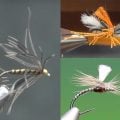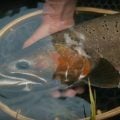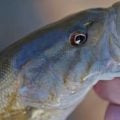“Chuggin’ The Moodah Poodah”

Chester Allen photo
There are two schools of fly anglers: Those that believe in matching the hatch — and those that worship the weird and wonderful.
The hatch matchers are usually serious trout anglers. They carry flies tied to imitate a specific bug at a specific moment in its life. These anglers carry boxes crammed with flies that imitate hatching bugs, egg-laying bugs, larval bugs, almost-dead bugs, long-dead bugs and bugs caught in the middle of life and death.
The weird and wonderful anglers are often bass addicts — or the mossy-backed, always-damp steelhead maniacs. A well-made bass popper looks like something from a 1950s comic book about evil invaders from space.
And the modern school of steelhead flies — with snaky, articulated shanks festooned with long hackles and dangly, wiggly legs — look like the creepy, fanged fish that prowl the darkest depths of the ocean.
I attend both schools, but I’m more of a hatch matcher when it comes to picky, wild trout, which are my favorite fish to pester. Nothing beats kneeling in shallow water and dropping a size 18 Pale Morning Sparkle Dun to a picky brown trout feeding on size 18 Pale Morning Duns.
But then came the Moodah Poodah.
What the Hell?
I discovered the Moodah Poodah — or did it discover me? — while rummaging through the fly bins at Blue Ribbon Flies in West Yellowstone, Montana. This shop is the cutting edge of hatch-matching trout fly design, and I shamelessly copy their creations.
The Moodah Poodah, a wild mixture of foam, rubber legs and synthetic yarn, almost jumped out of the bin into my hand.
“What is this thing?” I asked Katherine Robinson, one of the shop gurus.
“It’s a Moodah Poodah, and it works,” she said. “It could be a hopper, a beetle, a moth — lots of buggy things.”
I looked at the fly, which actually was invented in the trout-addled minds at FlyFishFood.com. It seems certain that certain herbs were smoked — or very rusty water sipped — when this fly was born.
Then again, I recalled finding the Chaos Hopper in a Blue Ribbon Flies bin years and years ago. The Chaos Hopper imitates a grasshopper all right — as seen through the fevered mind of Salvador Dali. On the water, the Chaos Hopper floats and wiggles like the real thing, and the sparse foam body bobs through choppy water, even after several fish chewings.
So, why not the Moodah Poodah?
Welcome to the Machine
I bought Moodah Poodahs in tan and screaming purple — if you can’t run with the craziness, don’t bother. Twenty minutes later, I was wadered up on the banks of the Madison River in Yellowstone National Park.
It was a blustery mid-September afternoon, and Yellowstone National Park was just coming off the peak of one most glorious grasshopper infestations in years. The meadows were alive with hoppers from late summer on — in some places, it looked like the ground was moving — and the trout dialed into them fast and often.
Trouble was, the peak catching was probably a couple weeks earlier. Some really good fly anglers haunt the Madison, and they know what to do during hopper season. By now, most of the trout in the river — mostly resident fish, with a few early fall runner browns and rainbows — had gotten a crash course in modern hopper design for days on end.
Still, the warm wind gusted though the grass, so why not try to find a slow learner? I sat on the grassy bank and watched hoppers flush and clatter into the river. Little trout eagerly whacked the struggling bugs, but the larger fish rose slowly and closely examined the wiggling naturals. They rejected most of the real bugs.
Sure, they wanted them, but they were wary.
After watching all this for a few minutes, I eased into the Madison and slowly minced my way through a maze of sunken weedbeds. My destination was a deep slot against the far bank, and the best way to fish it was to edge out just past the middle of the river and then use a downstream reach cast to plop the fly along the far bank.
Breaking Rules and Getting Lucky
A few years ago, this spot taught me a lot. The trout were used to feeling anglers stumbling up to the undercut bank and casting their hoppers and beetles upstream. I spooked more paranoid browns and rainbows than I fooled.
Actually, I didn’t fool any fish. But I learned to sit, watch and think about things.
Then I tried slowly, slowly, slowly crawling my way through the tall grass to the undercut bank. I only scared the big fish when I did this.
Finally, I tried slowly wading to the middle of the river from the roadside bank, using the many weedbeds for cover. It takes about 20 minutes to wade 20 yards. I started hooking a few fish.
On this day, I just hoped to see what one of the big browns would do at the sight of the Moodah Poodah.
My first cast plopped the fly about six inches from the trailing grass of the undercut. Nothing.
The next cast caught on the grasses — and then slid off and into the current.
Suddenly, a big brown appeared under the fly. It was kind of like watching a ghost appear in a horror movie.
The trout backed down with the fly for a few seconds —and then sank into the green depths.
I waited a couple of minutes and popped another cast in there. The fly slowly bounced downstream, as I fed line to stretch out the drift. I bungled one mend, and the fly dragged for a second or so before it went back to a dead drift. That second or two of drag made the fly dig into the current and then pop back, just like a little bluegill popper.
Then a big, spotted head appeared. When the head dropped back into the water, my fly was gone. I set the hook, and the trout dug for the undercut in flashes of buttery brown and yellow. The old Ross Gunnison buzzed as line vanished in lunging surges.
After some more tug and pull — which spooked other nice trout out of the hole — I slid the brown onto a semi-submerged weedbed for a quick photo. My heart rattled around in my chest. This was my first runner of the fall, and it came on a floating fly.
Riding That Little Chug
I wish I could tell you how clever I was, but most of this was sheer luck. Finding the Moodah Poodah, which was just weird enough — and new enough — to attract picky, fished-over trout was lucky.
Being on Yellowstone’s Madison River in the fall is always a lucky thing.
And that little bit of accidental stop-and-go drag — kind of a chug — got that whacked-out fly quivering at just the right time.
I hit my favorite hopper/beetle spots on the Madison, Gibbon and Firehole rivers during the next few days, until a cold snap turned most of the hoppers into shriveled corpses.
I’m no genius, but I knew that little, ripply chug made the Moodah Poodah a living thing to some nice fish.
I didn’t wallop on the trout, but I caught enough nice fish — especially brown trout — on windy afternoons to make me really happy.
I also learned that the Firehole is growing some big browns these days.
All it took was the Moodah Poodah, grass-rippling winds, sneaky wading, and a little bit of leg-wiggling drag.
After a few days of this, I walked back into Blue Ribbon Flies and showed Katherine a couple photos.
“Moodah Poodah,” she said. “Moodah Poodah.”











